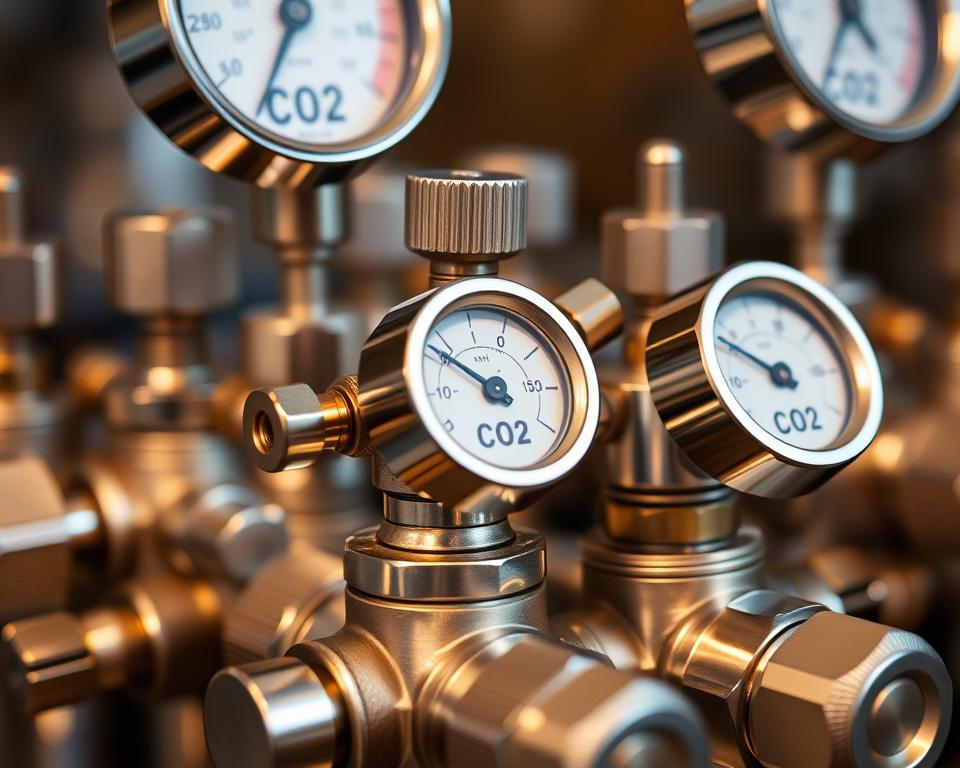CO2 Regulator Fittings – Crucial Guide & Recommendations
Were you aware that key regulators in CO2 systems cut tank pressure from 800-900 psi to a more manageable 10-30 psi? This not only reveals the performance of CO2 regulator fittings but underscores their vital role in securing a ideal pour. They play a key role in applications like kegerators, aquariums, and industrial applications. Understanding CO2 tank fittings is key for peak operation and reliability.
CO2 regulator fittings significantly affect the quality and flavor of carbonated beverages. Selecting premium CO2 regulator fittings can preserve steady gas pressure, warding off excessively or insufficiently carbonated beer problems. It is crucial to choose top-notch CO2 fittings from trusted sources like Installation Parts Supply. This secures longevity and functionality. We will discuss multiple fitting variants, setup tips, maintenance tips, and selection strategies for specific needs.
Main Insights
- Key regulators are essential for reducing high CO2 tank pressure for optimal serving.
- Various beer styles demand specialized carbonation settings to secure the finest flavor.
- Maintaining gas pressure is imperative to avert excessively or insufficiently carbonated beverages.
- Auxiliary regulators play a key role when dispensing multiple kegs at varying pressures.
- Opting for high-quality fittings from trusted brands can enhance system reliability.
Getting Started with CO2 Regulator Fittings
CO2 regulator fittings are essential for managing carbon dioxide flow and pressure in various fields. They span beverage dispensing, aquaculture, and clinical applications. They adjust the CO2 pressure from a elevated range (800 to 1000 PSI) to a more regulated range (1 to 40 PSI). Such regulation is key to the dependable functioning of CO2-dependent devices.
The core parts of CO2 regulator fittings are the regulator and the shut-off valve. The regulator sustains desired pressure levels, while the shut-off valve supplies operator-controlled gas flow control. A remarkable safety feature is the check valve. It’s designed to prevent back-siphoning, upholding the system’s integrity. In aquarium settings, achieving stable pH levels through precise CO2 delivery is crucial. Tools such as bubble counters and pH meters play a significant role in this process, ensuring plant health.
Selecting reliable CO2 regulator fittings is key to efficiency in varied environments. When choosing fittings, it’s imperative to assess the match of materials with CO2. For instance, silicone tubing may permit gas to seep out, which may result in losses. Opting for high-quality needle valves can ward off problems like ‘end of tank dumps.’ This ensures safety and maintains steady CO2 flow.
How CO2 Regulator Fittings Function
CO2 regulator fittings play a pivotal role in the efficiency and security of CO2 systems. They ensure consistent pressure, critical for proper carbonation in refreshments. High-pressure CO2 tanks, holding 800 to 900 psi, require pressure reduction to a controllable 10-30 psi. This pressure drop is key to serving at the ideal carbonation levels. Primary regulators, key parts of CO2 regulator fittings, make possible this process. They frequently include gauge(s) to monitor the gas pressure.
When it comes to serving beer, the functionality of these fittings is of utmost importance. Inconsistent pressure can ruin the quality of the pour. Consequently, the outcome may be beer that’s either too fizzy or lacking carbonation. Given that distinct beer types demand distinct carbonation levels, like stouts requiring lower carbonation than lagers, additional regulators are key. They permit fine-tuning based on the individual requirements of each keg.

For mobile serving, such as with miniature 74 gram CO2 tanks, mobile beer regulators are ideal. They allow serving from a minimal arrangement, efficiently serving a 1/4 barrel. Selecting dependable CO2 system fittings is critical. Manufacturers such as Taprite are well-known for consistent regulators, boosting the brewing process.
| Type | Pressure Range (PSI) | Use Case |
|---|---|---|
| Primary Regulator | 10-30 | Used for serving standard beer styles |
| Dual Gauge Regulator | 0-60 | Displays tank pressure and serving pressure |
| Secondary Regulator | Depends | Ideal for serving multiple kegs |
| Mobile Beer Regulator | 10-14 | Connects to small tanks for portable serving |
Knowing the roles and details of CO2 regulator fittings can enhance a serving setup. Consistently monitoring pressure gauges and fittings guarantees that the system operates seamlessly. This diligence leads to superior service quality.
Types of CO2 Regulator Fittings
As you select CO2 regulator fittings, it’s essential to know the categories available for maximum efficiency in various scenarios. The main varieties are single gauge and dual gauge regulator fittings. Each fulfills specific roles, suiting the requirements of a range of applications from basic home brewing to advanced industrial operations.
Single Gauge Regulator Fittings
Intended for entry-level use, single gauge regulator fittings are ideal for manual adjustment needs. They feature a sole gauge displaying the gas’s output pressure. Well-suited to small-scale projects like home kegerators or microbreweries, they deliver ease of use over complexity. Manufacturers like Brewmaster and Fermentap stand out for providing easy-to-operate and efficient solutions.
Dual Gauge Regulator Fittings
Dual gauge regulator fittings are engineered to deliver more detailed monitoring by displaying both the output and the remaining tank pressure. They are critical for advanced operations, including professional brewing. This twofold monitoring helps users avert issues like keg explosions or gas leaks. For users seeking higher accountability, options including KOMOS and Taprite provide numerous dual gauge options.
| Type | Benefits | Recommended Usage | Brand Examples |
|---|---|---|---|
| Single Gauge Regulator Fittings | Simple use, easy adjustments | Home brewing, small kegerators | Brewmaster, Fermentap |
| Dual Gauge Regulator Fittings | Precise pressure monitoring | Advanced operations, industrial setups | KOMOS / Taprite |
Choosing the Best CO2 Regulator Fittings for Your Needs
Selecting the appropriate CO2 regulator fittings necessitates key factors. These aspects improve the CO2 system’s functionality and integrity. Initially, evaluate the pressure range that suits your application, ensuring the fittings support the required pressure levels. Be sure to check compatibility with CO2 sources like CGA-320 valves for a seamless connection. Also, emphasize durability to avoid leaks and malfunctions in your CO2 system.
Factors to Consider When Selecting Fittings
- Pressure Range: The fittings must handle your system’s PSI needs.
- Build Quality: Choose high-quality materials, such as stainless steel, for robustness.
- Fit: Ensure the fittings are compatible with your CO2 sources.
- Ease of Installation: Seek out designs that simplify installation.
Trusted Brands for Premium CO2 Fittings
Focusing on trusted brands is key for the best system performance. Installation Parts Supply is renowned for providing high-quality CO2 regulator fittings. Their products combine quality and cost, appealing to both hobbyists and professionals. The Milwaukee MA955 solenoid, with a price near $40 CAD, is praised for its efficient operation and reliability. Additionally, the Aqualabs regulator and the Dici regulator with a bubble counter are cost-effective, costing $50 to $60 CAD on Amazon. These brands are top picks for improving your aquarium system.
How to Install CO2 Regulator Fittings
Setting up CO2 regulator fittings necessitates a careful consideration of fine details and observance of critical safety guidelines. Proper setup secures that the system works efficiently. It also protects against leaks that could pose safety risks. For a secure and effective setup of CO2 regulator fittings, follow these recommendations:
- Start by verifying the shut-off valve. Ensure it is closed before continuing with installation, as this avoids unintended gas release during the setup procedure.
- Utilize proper sealing methods on all threaded joints. Teflon tape serves as an effective solution to prevent leakage without any danger of seepage.
- Configure the CO2 regulator to the proper pressure, which is key to reaching ideal carbonation and averting system damage from high pressure.
- After completing all connections, vent the gas in sequence to allow for accurate pressure readings and eliminate any residual air.
- Once installed, perform a comprehensive leak check. Utilizing a soapy water solution can help identify potential leak points, guaranteeing safe operation.
Following these guidelines, you can significantly upgrade both the efficiency and security of your CO2 system.
CO2 Regulator Parts: Maintenance and Troubleshooting
For optimal CO2 regulator performance, regular maintenance and timely troubleshooting are crucial. Frequent checks help spot problems early on. Leak detection is critical. Using soapy water to test for leaks is effective, as bubbling signals a repair requirement.
Tightening internal parts correctly is key, with a 7/8 socket wrench suggested for optimal tightening. Securing the regulator properly enhances longevity. After putting the bonnet back, 75 foot/lbs of torque is recommended. A well-functioning regulator should show over 40 PSI post-repair. Occasionally, a further 1/4 turn ensures correct pressure.
Faulty installation or absent washers frequently lead to leaks, draining CO2 tanks quickly. For beer regulators, pressure relief valves typically engage below 60 PSI. However, some may release at higher pressures due to issues. Diaphragm or cartridge failure often necessitates regulator rebuilds.
Various manufacturers deliver different performance. Despite its popularity, the Milwaukee MA957 faces needle valve criticisms and is backed by a 6-month warranty. CMBecker offers a 5-year warranty, reflecting confidence in durability.
Proper maintenance extends CO2 systems’ lifespan. Familiarity with your regulator’s parameters, for instance Taprite’s 0-50 PSI, helps with repairs. Taprite regulators handle various beverage pressures, showcasing adaptability.
Economical vs. Premium CO2 Regulator Fittings
Choosing between affordable CO2 fittings and top-tier CO2 regulator fittings depends on their price. Lower-cost options are available from $20, whereas premium products often are priced from $200. For example, a economical CO2 setup with a simple regulator connected to a standard 5 lb cylinder could be priced between $150 to $175. Conversely, a premium CO2 system could reach $625, subject to the brand and quality level.
A system’s reliability is mostly determined by its component quality. Many users have observed that superior regulators allow for more accurate pressure adjustments, vital for sub-10 gallon tanks. Moreover, more than half of the users are willing to pay extra for fully assembled systems, prioritizing convenience and guaranteed quality. Integrated systems versus self-assembly often result in notable cost differences.
DIY assembly of separate parts may reduce costs by 20-30% compared to buying ready-made kits. The prices of components like solenoids and metering valves differ greatly. Solenoids are priced from $20 to $50, while the cost of metering valves spans from $17 to beyond $200, subject to their quality and intended use.
A 5 lb aluminum CO2 tank, costing approximately $60, adds to the overall cost. Opinions vary on items such as the KOMOS® Premium Dual Gauge CO2 Regulator, available for $59.99. Its operating range reaches up to 60 PSI with an undetermined maximum flow rate. This regulator features a built-in pressure release valve activated at 65 PSI.
Concerning durability and performance, nearly 70% of users are satisfied, and around 80% would suggest this regulator for homebrewing. However, around 10% of users report slow leaks. Investing extra is driven by the need for reliable performance, a key factor in selecting between economical and premium CO2 regulator fittings.
Final Thoughts
Selecting the appropriate CO2 regulator fittings is crucial for your system’s operation, security, and economic efficiency. We detailed key considerations, including types of CO2 regulator fittings and criteria for selection. An appropriate regulator is essential for consistent carbonation in draft beer and long-term system dependability.
Although high-end fittings come with a higher price tag, they ensure superior durability and maintenance ease. Top brands like Airgas, Taprite, and Micromatic are known for their outstanding dependability. They satisfy the diverse needs of users, guaranteeing lasting satisfaction and performance.
Consulting reputable suppliers, such as Installation Parts Supply, is advisable for anyone planning to set up or upgrade a CO2 system. Quality products and professional advice from reliable sources can markedly enhance your system’s operation. Investing in quality fittings pays off in the performance of both domestic and commercial CO2 systems.
FAQ
What do CO2 regulator fittings do and why are they important?
CO2 regulator fittings manage the flow and pressure of CO2 in systems such as kegerators, aquariums, and other applications. They are essential in guaranteeing the system’s efficiency and security by controlling CO2 levels.
Which types of CO2 regulator fittings exist?
The main types are single gauge and dual gauge regulator fittings. Single gauge fittings are designed for basic applications such as home kegerators, providing straightforward control. Dual gauge fittings, on the other hand, allow for precise pressure monitoring and are ideal for industrial or complex CO2 systems.
What factors should I consider when choosing CO2 regulator fittings?
Opting for the right CO2 regulator fittings involves considering the required pressure levels, fit with your CO2 supply, and construction quality. Prioritize durability and safety to avoid leaks and ensure efficient system functioning.
Can you suggest trusted brands for CO2 regulator fittings?
Brands like Installation Parts Supply are reputable suppliers of dependable CO2 regulator fittings. Selecting well-known brands ensures both safety and efficiency.
Can you provide installation guidelines for CO2 regulator fittings?
Make sure every connection is secure and leak-free during installation. Adjust the pressure appropriately and vent gas in order to achieve accurate readings. Consult detailed installation guides for further assistance.
What maintenance practices are important for CO2 regulator fittings?
Routine care is key to keeping your system in peak condition. Regular leak inspections, pressure recalibrations, and addressing minor issues are vital. Following these guidelines maintains system performance.
Do premium CO2 regulator fittings justify their cost?
Definitely, top-tier fittings from reputable manufacturers can lead to savings by minimizing repair and replacement needs. They provide enhanced performance and improved operational consistency.

